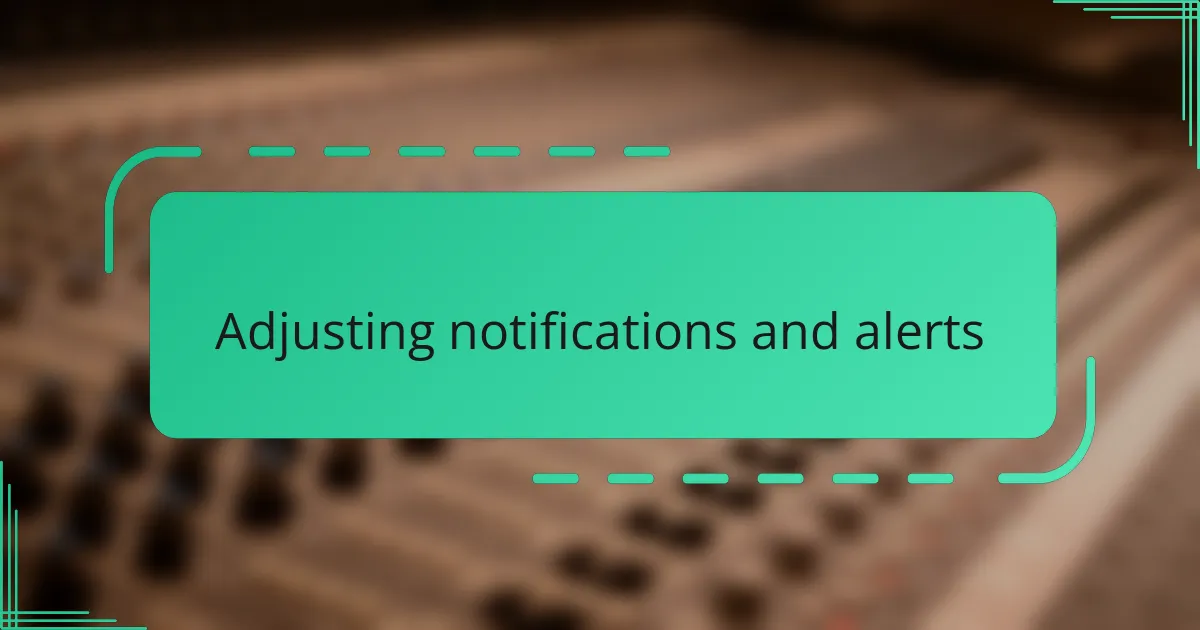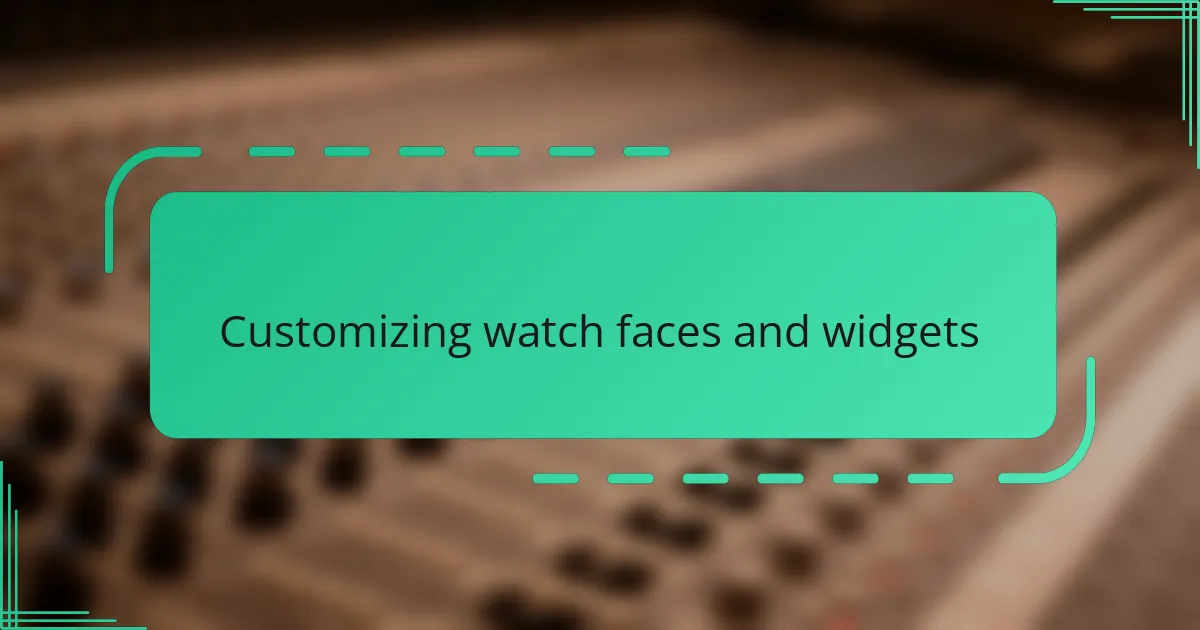Key takeaways
- Customizing smartwatch settings, such as notification preferences and health metrics, significantly enhances user experience and personal connection to the device.
- Adjusting features like vibration intensity and alert profiles can reduce distractions and create a more streamlined daily routine.
- Personalizing watch faces and widgets can transform a smartwatch into a unique accessory, tailored to individual style and needs.
- Setting realistic health and fitness goals tailored to personal routines makes tracking more motivating and meaningful.

Understanding smartwatch customization
Customizing a smartwatch goes beyond simply changing watch faces; it’s about tailoring a device that feels like an extension of yourself. When I first started tweaking my settings, I realized how much small adjustments—like prioritizing notifications or choosing which health stats to display—could transform my daily routine. Have you ever noticed how a subtle change in vibration intensity can make alerts feel less intrusive but still effective? That’s the kind of personalization that makes a smartwatch truly your own.

Exploring smartwatch settings options
Diving into the settings menu felt like opening a treasure chest full of possibilities. I found options to adjust screen brightness for battery saving and even change how long the display stays awake—with each tweak, the watch started to feel less like a gadget and more like a companion. Have you played around with setting different do-not-disturb schedules? It’s incredible how syncing quiet hours with your lifestyle can restore focus without missing important updates.
One feature that caught my attention was customizing notification preferences. Instead of getting bombarded by every app alert, I handpicked only the essential ones—calls, messages, and calendar reminders. This small change instantly reduced distractions and made me appreciate the smartwatch as a tool for convenience rather than stress. I often wonder why more people don’t explore these settings; it’s amazing how much control you have over your own experience.
Another setting I experimented with was the variety of health metrics displayed on the watch face. Choosing to highlight heart rate and step count, while hiding less relevant stats, made the data more meaningful to me throughout the day. Adjusting these preferences felt empowering because it turned a generic fitness tracker into a personal wellness coach, perfectly aligned with my goals. Have you customized your health stats yet? It’s surprisingly motivating to see the numbers that matter most to you.

Choosing essential features to personalize
Picking which features to personalize was a game-changer for me. It wasn’t just about having all the bells and whistles turned on, but about choosing what really mattered—like prioritizing notifications from my family over social media updates. Have you ever noticed how cutting down noise actually makes your smartwatch feel more like a helpful assistant than a distraction?
Sometimes, I would find myself overwhelmed by the sheer number of options, so I focused on what I used daily. For example, customizing fitness goals and sleep tracking stats to fit my routine made the data feel relevant rather than just numbers on a screen. It felt rewarding to tailor something so techy into something that genuinely supported my wellness journey.
What surprised me the most was how adjusting subtle features, like vibration intensity for alerts, could change my whole experience. It made me think: why settle for the default settings when a few tweaks can turn your device into something truly personal? Have you tried prioritizing features based on your lifestyle yet? It really shifts how you interact with your watch throughout the day.

Adjusting notifications and alerts
One thing I quickly realized was that not all notifications deserve my immediate attention. So, I went into the settings and turned off alerts from apps that tend to flood my watch with unnecessary pings. It was liberating to get only the notifications that truly mattered, like calls or messages from close friends. Don’t you think it’s amazing how cutting down that noise can bring a sense of calm?
Adjusting the vibration intensity was another small change that made a big difference for me. At first, the alerts felt a bit jarring, especially in quiet settings. Lowering the vibration made notifications subtle enough to be noticed without being disruptive. Have you ever tried tweaking this? It’s like teaching your watch when and how to get your attention gently.
I also set up different alert profiles depending on the time of day or activity. For instance, during work hours, only urgent notifications come through, while evenings include more social alerts. This customization made my day flow smoother and helped me focus without missing out on important updates. Isn’t it satisfying when technology adapts so seamlessly to your lifestyle?

Customizing watch faces and widgets
When I first explored changing watch faces, I didn’t realize how much personality I could inject into such a small screen. Picking a watch face that matched my mood or outfit made the watch feel less like a tool and more like an accessory. Have you ever noticed how a vibrant, animated face can brighten your day, while a minimalist design helps you stay focused?
Widgets turned out to be a game-changer in making quick info available at a glance. I customized mine to show weather updates, calendar events, and my next workout, so I didn’t have to dig through menus constantly. It’s funny how these little panels can make the watch feel like a personal assistant rather than just a gadget.
One adjustment I kept coming back to was rearranging widget order based on my daily routine. Morning widgets focus on productivity and weather, while evening ones shift toward relaxation features like music controls or sleep tracking. Tailoring this flow made the watch feel smarter—almost like it understood what I needed throughout the day. Have you tried reshuffling your widgets to match your rhythm? It’s surprisingly satisfying.
![]()
Optimizing health and fitness tracking
Optimizing health and fitness tracking was where I saw the most immediate impact from personalization. I started by setting realistic daily step and activity goals that matched my usual routine, instead of generic targets that felt either too easy or unreachable. Have you noticed how hitting a goal tailored just for you motivates you more than some arbitrary number? For me, it turned fitness from a chore into a challenge I actually looked forward to.
Another tweak that made a big difference was customizing which health stats appeared on my watch face. I prioritized heart rate and active minutes because those numbers gave me meaningful insights during workouts. It felt empowering to glance down and instantly get data that was relevant, rather than being overwhelmed by everything the watch could track but I didn’t really need.
Sleep tracking was a surprise favorite. By adjusting the sensitivity and setting personalized sleep goals, I started understanding my rest patterns in a way that felt practical, not just theoretical. Have you ever wondered why some nights feel refreshing and others don’t? My watch helped me connect the dots, and that insight nudged me to improve my bedtime habits, which made a real difference in daily energy.



